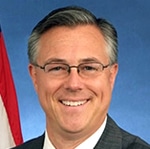Legislators in both the North Carolina state House and Senate have introduced bills to keep freight rail operations on the state’s more than 3,300 miles of track running safely and efficiently. A bus safety bill is also in the works in the state.
H.B. 408 and S. 348 require a crew of at least two qualified people in the operating locomotive of trains transporting cargo and hazardous materials in the state for public safety. H.B. 408 has four bipartisan primary sponsors including Rep. Wayne Sasser (R – Dist. 67), Rep. Carolyn Logan (D – Dist. 101), Rep. Charles Graham (D – Dist. 47) and Rep. Verla Insko (D – Dist. 56), and 30 co-sponsors. The Senate version of the bill got a late start due to the Ninth Circuit court ruling and so S. 348 only has two Democratic primary sponsors including Sen. Sarah Crawford (D – Dist. 18) and Sen. Julie Mayfield (D – Dist. 49), and three co-sponsors. Both bills have had their first reading and have been referred to the Transportation Committee and Rules Committee, respectively.
“It is vitally important to maintain the presence of two crew members in the locomotive,” said Ron Ingerick, North Carolina state legislative director of the SMART Transportation Division. “Despite any advances in technology, there is a safety factor called ‘the Rule of 2’ in having the engineer and the conductor in the cab, just like how airplanes have pilots and co-pilots. With the size and complexity of the modern freight train, each crew member has responsibilities, and simultaneously performs duties in providing safe and efficient operation. These crew members are the first responders to a grade crossing collision, derailment or other emergency situation.
“The public safety of our communities is non-negotiable, and H.B. 408 and S. 348 will help prevent potential accidents or derailments. The citizens of North Carolina deserve to feel safer with two crew members in the cab in the trains that roll through their communities, day and night.”
Another bill filed in the House looks to curtail railroads’ use of giant trains that block crossings. H.B. 438, filed March 29, has three Republican representatives as primary sponsors: Rep. Howard Penny (R – Dist. 53), Rep. Jerry Carter (R – Dist. 65) and Rep. Mike Clampitt (R – Dist. 119). The bi-partisan bill currently has 21 co-sponsors — two of which are the Chairman and Vice Chairman of the Transportation Committee — and is still accepting more. H.B. 438 intends to place a limitation on train length, which has been growing from an average length of a mile and a half five years ago to now sometimes exceeding four miles. The main culprit is an operating strategy initiated in 2017 by the nation’s biggest railroads called Precision Scheduled Railroading (PSR).
“Since the evolution of PSR, trains in this state have increased in length and weight, with haphazard train builds, fewer safety-critical inspections, and maintenance being deferred —increasing the risk of derailments,” said Ingerick, who is an active railroader, as well as our N.C. state legislative director who brings awareness to legislators in Raleigh. “A train that is longer is harder to operate. Also, concerns have risen from local communities and emergency responders as these longer trains have increased instances of blocked crossings.”
Blocked rail crossings cause an inconvenience for motorists, who must find alternate routes, especially in rural areas. They also pose a safety risk to pedestrians who may attempt to go under or climb over rail cars to continue their travels. A blocked crossing can play a part in delaying or detouring emergency responses when seconds or minutes count, sending responders out of their way when their aid is needed.
“Railroads are looking at returns and how their stocks are doing on Wall Street,” Ingerick said. “PSR puts safety last and profit first and makes a dangerous business even riskier.”
Lastly, Ingerick reports that the Bus Safety Risk Reduction Act has been released from bill drafting and will be filed in the coming week. The bill will include risk analysis, barriers, de-escalation training and data collection.
“Overall, I feel that we’re in a good position right now concerning these bills, but we need continued involvement from the membership in order to get these bills passed,” Ingerick said.
Tag: North Carolina
In a move that carrier officials said was in reaction to the COVID-19 pandemic, Norfolk Southern has idled the hump yard at Linwood Terminal in North Carolina, costing more than 80 people their jobs.
NS told Trains Magazine May 1 that the “unforeseeable business circumstances” caused by the coronavirus will result in 85 jobs lost this month at the site, which has been open since 1979.
Norfolk Southern announced first-quarter revenue of $2.6 billion and net income of $381 million on April 29. The carrier said it took a $385 million loss during the quarter as it sold off approximately 300 locomotives and is in the process of selling 400 more as part of its Precision Scheduled Railroading plan.
“We are taking hard looks at our yard and terminal network, testing what we can live without,” Chief Operating Officer Mike Wheeler said during the carrier’s first-quarter earnings call.
Read the article from Trains Magazine (registration may be required).
Union Pacific also has curtailed operations at an engine shop in North Little Rock, Ark., for reasons identical to those cited by NS, the Arkansas Democrat-Gazette reported, also on May 1.
Workers at the Jenks Locomotive Facility began to be notified on April 30 of worker furloughs. Carrier representatives declined to disclose an exact number of employees affected to the newspaper but said the carrier would re-evaluate operations in a couple of weeks.
Approximately 1,100 people work at the facility, the newspaper reported.
UP reported $1.5 billion in net income for the first quarter during its earnings call April 23.
Read the Arkansas Democrat-Gazette’s report.
Earnings data for the majority of Class I freight carriers will be published on the TD website next week.
With the partial federal government shutdown in its 35th day on Jan. 25, many small- to mid-sized transit agencies are reporting a financial pinch, Politico.com reports.
Agencies in North Carolina, Missouri, Arizona and California all say that cuts in service are on the table if the shutdown persists.
And at least one transit provider, Cape Fear Public Transportation Agency in Wilmington, N.C., is considering a plan to not operate in February because of a lack of funds. Its executive director reports that Federal Transit Administration (FTA) reimbursements for the first four months of the fiscal year have not been processed with each reimbursement representing a quarter of its monthly operating budget.
But even if the shutdown ended soon, it would not guarantee that the payments would arrive to fund operations, executive director Albert Eby told Politico.com.
Read the full story at politico.com.

Halifax County Sheriff’s Chief Deputy Bruce Temple said the accident happened around noon in the town of Halifax.
Read the complete story at the Associated Press.

RICHMOND, Va. – Federal Railroad Administrator Joseph C. Szabo today called on elected officials and transportation planners in Virginia, North Carolina, South Carolina and Georgia to develop a shared vision of rail service along the Southeast High-Speed Rail Corridor (SEHSR) between Washington, D.C., and Atlanta. Administrator Szabo’s challenge came as he addressed members and supporters of Virginians for High-Speed Rail during their 20th anniversary luncheon in Richmond.
“The metropolitan regions of the South and the Southeast in particular, are growing faster than other metropolitan regions across the country,” said U.S. Transportation Secretary Anthony Foxx. “In order to meet the mobility needs of a growing population and to move the products they will need to market, rail must play an enhanced role in the transportation delivery network there.”
Across the country, regions are banding together to forge collective long-term visions for passenger rail. Along the Northeast Corridor (NEC), eight states and the District of Columbia are working on a 40-year plan for rail service between Boston and Washington, D.C. In the Midwest, nine states and 40 cities have already developed the Midwest Regional Rail Initiative, a planning guide for long-term rail investments.
“Good planning is the cornerstone of service delivery and a plan reflecting the collective vision for a region helps the region compete effectively for future rail funds as money becomes available,” said Joseph C. Szabo, Federal Railroad Administrator. “In order for the region to achieve optimum growth, it will be necessary for them to work together more closely and plan for their transportation future.”
Administrator Szabo said regional planning between Virginia, North Carolina, South Carolina and Georgia could effectively yield seamless passenger rail travel all along the East Coast from Boston to Atlanta.
During his address, Administrator Szabo also highlighted the importance of the Grow America Act , the Obama Administration’s four-year $302 billion surface transportation reauthorization bill now before Congress. The bill includes $19 billion for rail, and for the first time, would provide railroads with a predictable, dedicated funding source. The Act will invest $600 million in existing state corridors like the Southeast High Speed Rail Corridor and provide an additional $6.4 billion for rail service improvements along existing, expanding and new passenger corridors over the next four years.
Passenger ridership has been setting record highs in the Southeast. In Virginia, passenger ridership is up 100 percent since 2009 and in North Carolina Amtrak’s Piedmont service between Charlotte and Raleigh continues to set ridership records carrying about 100,000 more people in 2013 than it did in 2009. Since 2007, passenger ridership in Georgia increased by 15 percent and by 14 percent in South Carolina.
Similarly, freight rail traffic in the Southeast has been increasing since 2009 an average of 10 percent annually. Georgia has seen an increase of nearly 13 percent with a more than 883,000 carloads of freight annually.
The Federal Railroad Administration, along with its 32 state partners and the District of Columbia, is laying the foundation for a higher performance rail network. Sixty-five projects worth $4.1 billion in High-Speed Intercity Passenger Rail Program funding are currently completed, under construction, or will soon start construction in 20 states and the District of Columbia. Today, about $736 million in federal funding supports a dozen projects along the Southeast High Speed Rail Corridor.
